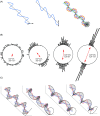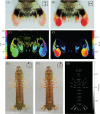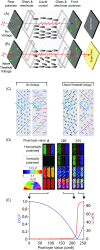Polarisation vision: overcoming challenges of working with a property of light we barely see
- PMID: 29589169
- PMCID: PMC5871655
- DOI: 10.1007/s00114-018-1551-3
Polarisation vision: overcoming challenges of working with a property of light we barely see
Erratum in
-
Correction to: Polarisation vision: overcoming challenges of working with a property of light we barely see.Naturwissenschaften. 2018 May 3;105(5-6):32. doi: 10.1007/s00114-018-1559-8. Naturwissenschaften. 2018. PMID: 29744587 Free PMC article.
Abstract
In recent years, the study of polarisation vision in animals has seen numerous breakthroughs, not just in terms of what is known about the function of this sensory ability, but also in the experimental methods by which polarisation can be controlled, presented and measured. Once thought to be limited to only a few animal species, polarisation sensitivity is now known to be widespread across many taxonomic groups, and advances in experimental techniques are, in part, responsible for these discoveries. Nevertheless, its study remains challenging, perhaps because of our own poor sensitivity to the polarisation of light, but equally as a result of the slow spread of new practices and methodological innovations within the field. In this review, we introduce the most important steps in designing and calibrating polarised stimuli, within the broader context of areas of current research and the applications of new techniques to key questions. Our aim is to provide a constructive guide to help researchers, particularly those with no background in the physics of polarisation, to design robust experiments that are free from confounding factors.
Keywords: Artefact; Imaging; Measurement; Methods; Polarisation; Vision.
Figures














References
-
- Able KP, Able MA. Daytime calibration of magnetic orientation in a migratory bird requires a view of skylight polarisation. Nature. 1993;364:523–525.
-
- Arwin H, Magnusson R, Landin J, Järrendahl K. Chirality-induced polarisation effects in the cuticle of scarab beetles: 100 years after Michelson. Phil Mag. 2012;92:1583–1599.
-
- Bainbridge R, Waterman TH. Polarised light and the orientation of two marine Crustacea. J Exp Biol. 1957;34:342–364.
-
- Bidwell NJ, Goodman LJ. Possible functions of a population of descending neurons in the honeybee’s visuo-motor pathway. Apidologie. 1993;24:333–354.
-
- Blake R, Cool SJ, Crawford MLJ. Visual resolution in the cat. Vis Res. 1974;14:1211–1217. - PubMed
Publication types
MeSH terms
Grants and funding
LinkOut - more resources
Full Text Sources
Other Literature Sources

